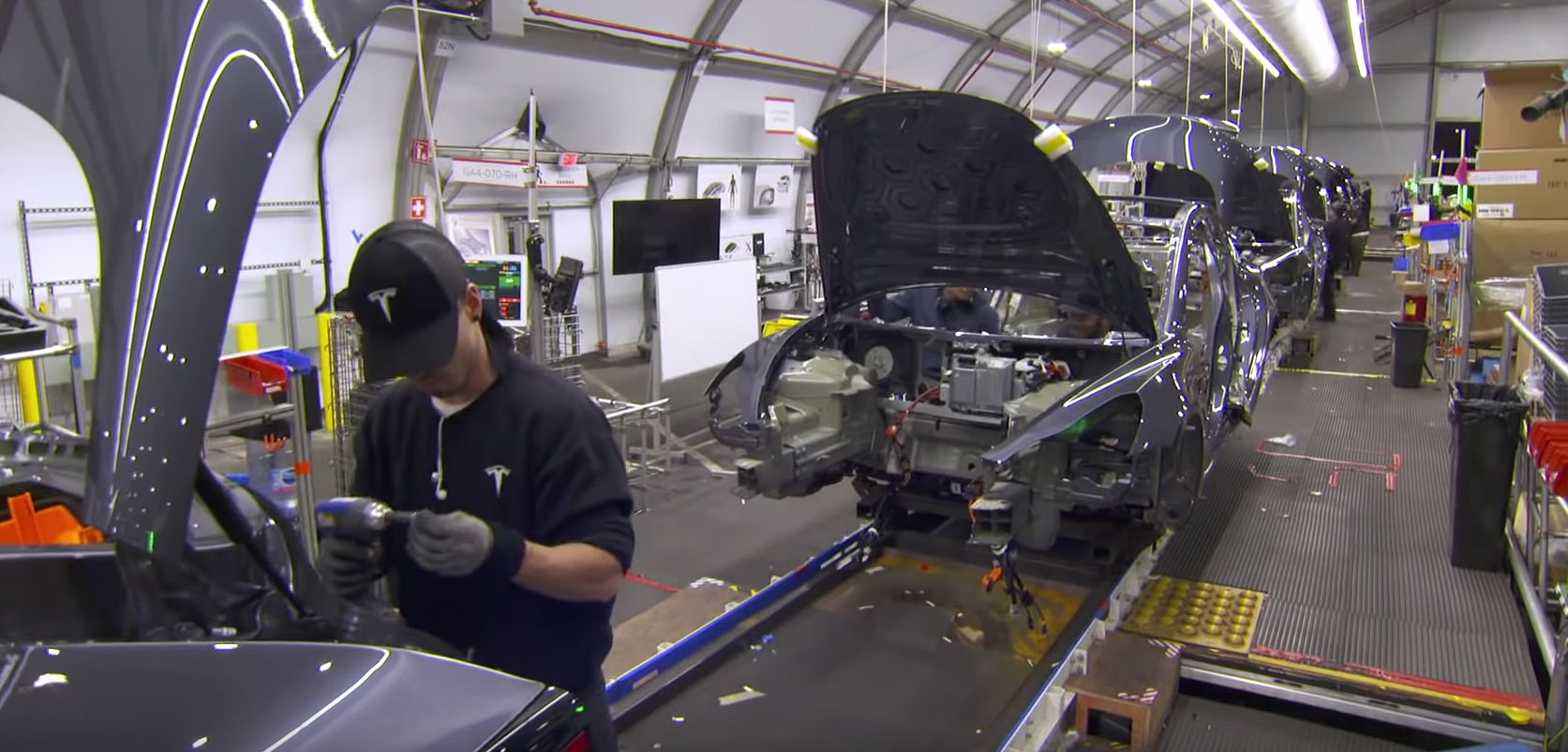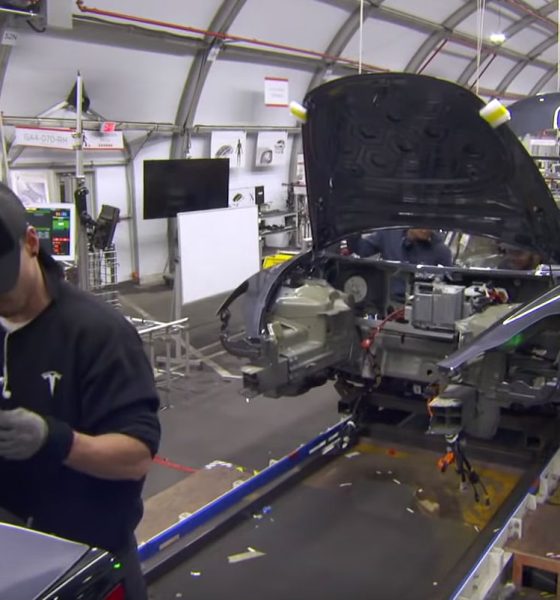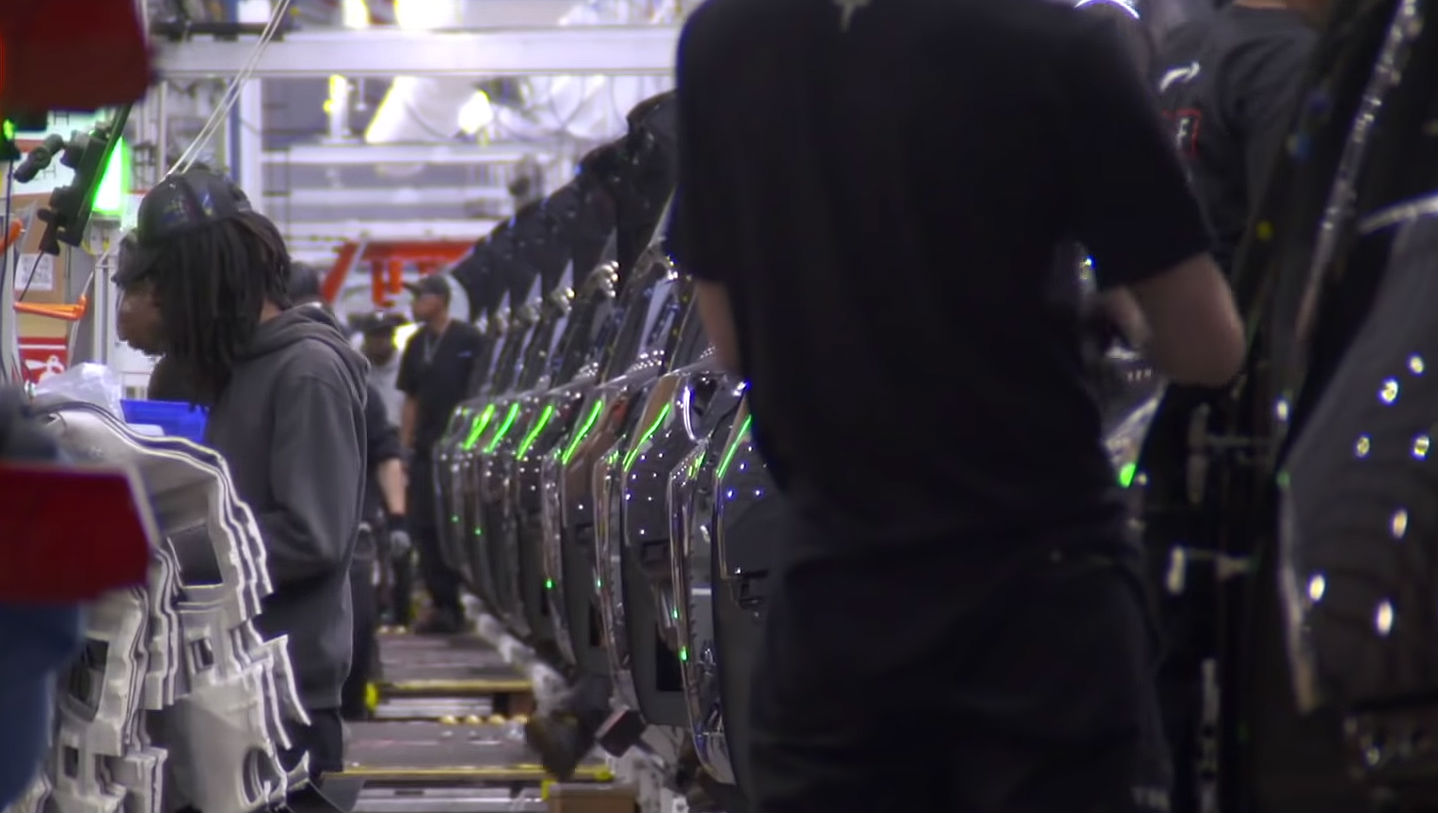

Investor's Corner
Inside Tesla’s ‘tent’-based Model 3 line that set a path to profitability
Tesla attracted more headlines than usual when Elon Musk announced on Twitter that the company is introducing a new Model 3 assembly line inside a sprung structure on the grounds of the Fremont factory. Casually dubbed by Elon Musk as a “tent,” the assembly line, dubbed GA4, played a huge part in pushing Tesla towards profitability in the third quarter.
Tesla’s “tent”-based Model 3 assembly line was featured in Elon Musk’s recent segment on CBS’ 60 Minutes. While speaking with correspondent Leslie Stahl, Musk remarked that the assembly line, which took only three weeks to set up, was responsible for boosting Model 3 production by 50%. That was enough to push the company to reach its self-imposed 5,000 Model 3 per week target in the second quarter.
Elon Musk has noted that Tesla is now at a point when it could produce 5,000 Model 3 per week without any problems. Before the company reached this point, though, it had to pass through a period that Musk personally described as “production hell.” During the second quarter, Tesla struggled to ramp Model 3 output using the vehicle’s two assembly lines inside the Fremont factory itself. When it was evident that this could not be achieved, Tesla did the unexpected — it built a third Model 3 line (GA4) to augment its output.
The construction of the “tent”-based line was lauded by the company’s supporters and criticized heavily by Tesla’s skeptics. Inasmuch as the sprung structure was controversial, though, it worked, and it ultimately helped Tesla address the Model 3’s production problems then. When he announced the promotion of Jerome Guillen as Tesla’s new President of Automotive, Musk stated that GA4 was the brainchild of the longtime problem-solver, who was working as the lead of the Tesla Semi program then. Considering how much GA4 helped Tesla reach its production goals, it is not difficult to speculate that the construction of GA4 was one of the reasons behind Jerome Guillen’s promotion to President of Automotive.
CBS correspondent Leslie Stahl noted during the recent 60 Minutes segment that the “tent”-based Model 3 line, contrary to Elon Musk’s initial plans for a fully-automated car factory, is currently filled with human workers. Musk noted during the segment that “People are way better at dealing with unexpected circumstances than robots,” while sharing a laugh with some workers assembling the Model 3.

Speaking with investors back in 2016, Elon Musk noted that Tesla’s electric car factories will be a “machine that builds the machine.” Musk even shared that the codename for the project is “Alien Dreadnought” — a reference to the hyper-advanced extraterrestrial crafts featured in sci-fi films and literature. The CEO initially estimated the dreadnought to be operational by the end of 2018, though the “production hell” that ensued during the Model 3 ramp forced Elon Musk to admit that over-automation was a mistake. Admitting his miscalculation on Twitter, Musk humbly noted that “humans are underrated.”
If there is one lesson that Tesla learned this year, it is that unorthodox solutions such as its “tent”-based Model 3 line — while a step away from Elon Musk’s original vision — are needed for the company to hit its goals. Using a makeshift production line that’s populated with human workers might not be part of Elon Musk’s “Alien Dreadnought,” but it was exactly what Tesla needed to push towards its manufacturing targets. If any, Tesla’s stellar performance in the third quarter, when it surprised Wall Street and skeptics by posting $6.8 billion in revenue, was made possible in no small part by the “tent”-based Model 3 assembly line.
Ultimately, GA4 could serve as a template for the company’s upcoming electric car production facilities, particularly as Tesla is currently setting the stage for Gigafactory 3, which would produce the Model 3 and Model Y for the local Chinese market. Gigafactory 3 is in an extremely aggressive timetable — one which Wall Street even dubbed as “not feasible.” If Tesla can maintain its open-mindedness and its tendency to adopt out-of-the-box solutions, though, even ambitious projects such as Gigafactory 3 would be more than feasible.
Watch 60 Minutes‘ segment on Tesla’s “tent”-based Model 3 assembly line in the video below.

Investor's Corner
Tesla stock closes at all-time high on heels of Robotaxi progress

Tesla stock (NASDAQ: TSLA) closed at an all-time high on Tuesday, jumping over 3 percent during the day and finishing at $489.88.
The price beats the previous record close, which was $479.86.
Shares have had a crazy year, dipping more than 40 percent from the start of the year. The stock then started to recover once again around late April, when its price started to climb back up from the low $200 level.
This week, Tesla started to climb toward its highest levels ever, as it was revealed on Sunday that the company was testing driverless Robotaxis in Austin. The spike in value pushed the company’s valuation to $1.63 trillion.
Tesla Robotaxi goes driverless as Musk confirms Safety Monitor removal testing
It is the seventh-most valuable company on the market currently, trailing Nvidia, Apple, Alphabet (Google), Microsoft, Amazon, and Meta.
Shares closed up $14.57 today, up over 3 percent.
The stock has gone through a lot this year, as previously mentioned. Shares tumbled in Q1 due to CEO Elon Musk’s involvement with the Department of Government Efficiency (DOGE), which pulled his attention away from his companies and left a major overhang on their valuations.
However, things started to rebound halfway through the year, and as the government started to phase out the $7,500 tax credit, demand spiked as consumers tried to take advantage of it.
Q3 deliveries were the highest in company history, and Tesla responded to the loss of the tax credit with the launch of the Model 3 and Model Y Standard.
Additionally, analysts have announced high expectations this week for the company on Wall Street as Robotaxi continues to be the focus. With autonomy within Tesla’s sights, things are moving in the direction of Robotaxi being a major catalyst for growth on the Street in the coming year.
Elon Musk
Tesla needs to come through on this one Robotaxi metric, analyst says
“We think the key focus from here will be how fast Tesla can scale driverless operations (including if Tesla’s approach to software/hardware allows it to scale significantly faster than competitors, as the company has argued), and on profitability.”

Tesla needs to come through on this one Robotaxi metric, Mark Delaney of Goldman Sachs says.
Tesla is in the process of rolling out its Robotaxi platform to areas outside of Austin and the California Bay Area. It has plans to launch in five additional cities, including Houston, Dallas, Miami, Las Vegas, and Phoenix.
However, the company’s expansion is not what the focus needs to be, according to Delaney. It’s the speed of deployment.
The analyst said:
“We think the key focus from here will be how fast Tesla can scale driverless operations (including if Tesla’s approach to software/hardware allows it to scale significantly faster than competitors, as the company has argued), and on profitability.”
Profitability will come as the Robotaxi fleet expands. Making that money will be dependent on when Tesla can initiate rides in more areas, giving more customers access to the program.
There are some additional things that the company needs to make happen ahead of the major Robotaxi expansion, one of those things is launching driverless rides in Austin, the first city in which it launched the program.
This week, Tesla started testing driverless Robotaxi rides in Austin, as two different Model Y units were spotted with no occupants, a huge step in the company’s plans for the ride-sharing platform.
Tesla Robotaxi goes driverless as Musk confirms Safety Monitor removal testing
CEO Elon Musk has been hoping to remove Safety Monitors from Robotaxis in Austin for several months, first mentioning the plan to have them out by the end of 2025 in September. He confirmed on Sunday that Tesla had officially removed vehicle occupants and started testing truly unsupervised rides.
Although Safety Monitors in Austin have been sitting in the passenger’s seat, they have still had the ability to override things in case of an emergency. After all, the ultimate goal was safety and avoiding any accidents or injuries.
Goldman Sachs reiterated its ‘Neutral’ rating and its $400 price target. Delaney said, “Tesla is making progress with its autonomous technology,” and recent developments make it evident that this is true.
Investor's Corner
Tesla gets bold Robotaxi prediction from Wall Street firm
Last week, Andrew Percoco took over Tesla analysis for Morgan Stanley from Adam Jonas, who covered the stock for years. Percoco seems to be less optimistic and bullish on Tesla shares, while still being fair and balanced in his analysis.

Tesla (NASDAQ: TSLA) received a bold Robotaxi prediction from Morgan Stanley, which anticipates a dramatic increase in the size of the company’s autonomous ride-hailing suite in the coming years.
Last week, Andrew Percoco took over Tesla analysis for Morgan Stanley from Adam Jonas, who covered the stock for years. Percoco seems to be less optimistic and bullish on Tesla shares, while still being fair and balanced in his analysis.
Percoco dug into the Robotaxi fleet and its expansion in the coming years in his latest note, released on Tuesday. The firm expects Tesla to increase the Robotaxi fleet size to 1,000 vehicles in 2026. However, that’s small-scale compared to what they expect from Tesla in a decade.
Tesla expands Robotaxi app access once again, this time on a global scale
By 2035, Morgan Stanley believes there will be one million Robotaxis on the road across multiple cities, a major jump and a considerable fleet size. We assume this means the fleet of vehicles Tesla will operate internally, and not including passenger-owned vehicles that could be added through software updates.
He also listed three specific catalysts that investors should pay attention to, as these will represent the company being on track to achieve its Robotaxi dreams:
- Opening Robotaxi to the public without a Safety Monitor. Timing is unclear, but it appears that Tesla is getting closer by the day.
- Improvement in safety metrics without the Safety Monitor. Tesla’s ability to improve its safety metrics as it scales miles driven without the Safety Monitor is imperative as it looks to scale in new states and cities in 2026.
- Cybercab start of production, targeted for April 2026. Tesla’s Cybercab is a purpose-built vehicle (no steering wheel or pedals, only two seats) that is expected to be produced through its state-of-the-art unboxed manufacturing process, offering further cost reductions and thus accelerating adoption over time.
Robotaxi stands to be one of Tesla’s most significant revenue contributors, especially as the company plans to continue expanding its ride-hailing service across the world in the coming years.
Its current deployment strategy is controlled and conservative to avoid any drastic and potentially program-ruining incidents.
So far, the program, which is active in Austin and the California Bay Area, has been widely successful.








